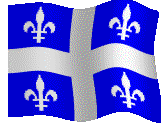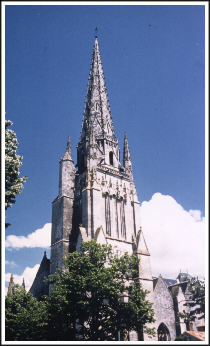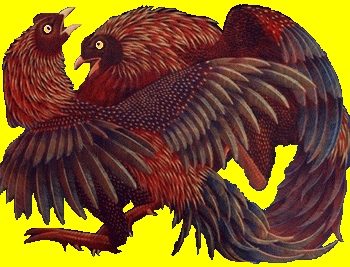![]()
|
![]()
|
Pierre Michaud was born to a merchant family in Poitou, France. His parents were Antoine Michel and Marie Train, and he was baptised in the Church of Notre Dame, on Rue Pont-aux-Chevres, Fontenay-le-Comte, in 1637. The 240-foot-tall church is still one of the most noticable landmarks in this historic medieval city on the Vendée River.
In 1655, his father arranges for Pierre to apprentice with Jacques Audouit "who promises to teach him his craft and skills, as a hat decorator and all the ensuings..." Pierre's apprenticeship lasts barely a year, for the restless young man realizes that he is not well suited for a career as a haberdasher. So, on March 27, 1656, before Notary Paul Moreau of La Rochelle, Pierre indentures himself to Jacques Pepin, a ships' factor and merchant, to work in Québec for three years. In return, he is paid 36 livres (pounds) per year, with an immediate advance of 38 livres and 5 sols, and given passage to New France. He travels on "LaFortune", a three masted ship owned by Monsieur Auboyneau. This small ship, only 100 tons, was commanded by Master Edouard Raymond, and must have made for a very crowded passage across the stormy spring-time Atlantic. This is a period of great unrest in France, and more than 30 other people emigrated from Fontenay-le-Comte for New France, including Pierre Cardinal, Jacques Bernier, Andre Bonnenfant, Jacques Manseau, Pierre Bourgoin, and Pierre l'Ecuyer. Many other families from the Vendée would also make the passage to the New World around this time, including Olivier D'Aigre, René Ancelin, Noël Simard, René Albert, and the brothers Gilles and Jean Gaudreau (all families related to my branch of the Michaud family). Pierre first settled on the Beaupré (North) coast of the St. Lawrence River, near Québec, where the first official mention of him in Canada is found in the Register of Receipts and Expenditures of the Church of Sainte-Anne-du-Petit-Cap in 1661-1662: 'to pierre micheau (Michel) for two days three livres.' Pierre performing manual labor in the construction of the grand new Church of Sainte-Anne-de-Beaupré.
As Mother Marie de l'Incarnation noted in 1665: "Seven leagues distant from Québec is a village called "le Petit Cap" (the Little Cape), where there is a church of Saint Anne..... It is here that paralytics walk once more, that the blind recover their sight, and the sick are returned to health, whatever their affliction may be...." Sainte-Anne-de-Beaupré is the oldest of Canada's religious pilgrimage sites. In fact, immediately after the original chapel was built in 1658, the first miracle is said to have occurred at Sainte-Anne-du-Petit-Cap when a group of stranded seamen were rescued along Cape Tourmente. Today, more that 1.5 million people visit Sainte-Anne's basilica on Côte-de-Beaupré to pray to the mother of the Virgin Mary. In August, 1663, a sales contract lists "Pierre Micheau" as a partner of Michel Marquiseau in the ownership of three arpents (one arpent equals 0.85 acres) in the village of Beaupré, to the east of the Sainte-Anne River -- land which he sold two years later to Francois Daniau. He is not listed in the census of 1666 or 1667 so it is likely Pierre worked away from Sainte-Anne, possibly as a hired farm hand, a coureur de bois (lumberjack), or maybe even a member of the Carignan Regiment. But by the end of the summer of 1667, Pierre was confortable enough with his situation to think about marriage and amend the text of his marriage contract. The notary at the time called him: 'Pierre Michel, habitant of Sainte-Anne du Petit-Cap coast and seigneurie of Beaupré...' so we know he was still in the same area. For some reason, Pierre's marriage was delayed for about three years, and this contract was never signed. His fiancée, Marie Ancelin, lived with her father and stepmother at Ange-Gardien, on the Beaupré coast near Château Richer. Her father, René Ancelin, was a thread-mill worker from La Rochelle, where Marie had been born in May, 1654. Her father, three and a half years after the death of his first wife, the late Claire Rousselot, remarried, to Marie Juin in La Rochelle on January 19, 1665. The following spring, they emigrated to Canada, bringing 11-year-old Marie with them. At Ange-Gardien in 1667, they owned two head of cattle and 6 arpents of cultivated land. Their neighbors were Abraham Fiset and Jacques Achon. We also know that, on May 18, 1669, Marie Ancelin was the godmother at the baptism of her half-sister, Marie, at Ange-Gardien, so she was still there and not yet married to Pierre. According to Leon Roy, in June 1667, Pierre Michaud obtained a land grant of three arpents of river frontage on Île d'Orléans from Monsignor Laval, the first Bishop of Quebec. It was located in Saint-Jean parish, between neighbors Robert Boulay and Louis Bibet. Jacques Cartier, when he saw this island in 1535, called it the Isle of Bacchus, because of the large quantities of grapes growing there. The Native Americans called it Ouindigo, or Sorcerer's Isle.
Records indicate that he was still there in 1670, and that he was in good company, as his fiancée, Marie, and her parents now lived on the island as well. In fact, on March 26, 1670, Marie Ancelin was the godmother to the infant of Antoine Pepin (dit Lachance) and Marie Teste. It is possible that Pierre and Marie were married by this time, but there are no records to prove it. As we know is that they were married some time between 1669 and 1671 on l'Île d'Orléans. It may be there is no record because the traveling missionary priest who married them forgot to record the act in the register of Notre-Dame-de-Québec, a not-uncommon occurrence for the time. Pierre seems to have been a sporting man, and a person of strong convictions, for in 1671 he filed a criminal suit against Mathurin Thibodeau dit Lalime, another local settler from the Vendée region of France, over a matter involving a hunting rifle and a dog. It is not clear who won this lawsuit, or why the situation escalated so far that it required litigation, but in an ironic turn of events, it is worth noting that the two children of these litigants born on Île d'Orléans that same year -- Pierre's son, Pierre, and Mathurin's daughter, Marie-Madeleine, were married, at the Church of Notre-Dame de Québec, on February 5, 1697.
However, back in 1671, we know that Pierre and Marie Ancelin were married and could start looking for larger holdings upon which to raise their family. They turned their eyes toward the virgin territories further east on the St. Lawrence River and left Île d'Orléans... | ||||||||||||
|
|

![]()
HOME
|
Writing Resource Page
|
Genealogy Page
|
INDEX
|
|
![]()



